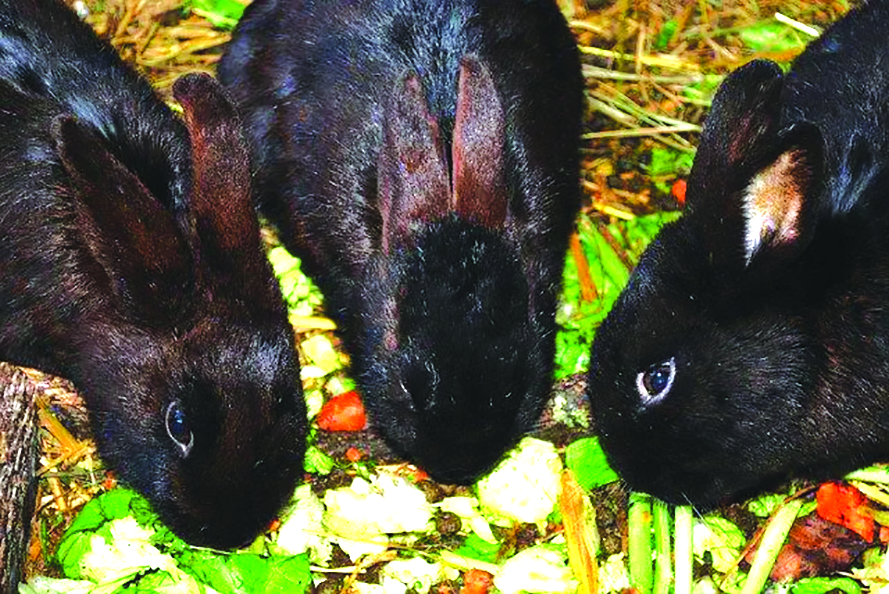Rabbit meat contains low kilojoule content per serving but with a high concentration of protein. Due to its health properties, with the Food and Nutrition Organisation describing rabbit meat as the healthiest available as a result of its high protein and low-fat content, the meat is now trending especially in European restaurants.
“Rabbit meat is healthy,” says Daisy Moleko. “The health benefits of rabbit meat are galore.”
Moleko established the Tjhesa Rabbit Buy & Braai Outlets, as well as “RabbLicious Restaurant”, a rabbit-only restaurant in Midrand, Gauteng. She is also the driving force behind the MPBizRabbitry agricultural value chain model that researches the markets, health benefits and commercial viability of rabbit meat.
“Slowly we are introducing the meat in SA and we are on the right track,” she says.
In the South African setting, the demand for rabbit meat is increasing as a result of the growing number of producers making enquiries about the farming practices of rabbit. According to Business Insider about 80% of South Africa’s rabbit meat is destined for export markets while only 20% is consumed domestically. Domestic consumption of rabbit meat is still low and the local market is still in its infancy.
Rabbit farming is considered an ideal project to start off small and watch as it grows with time. In many rural areas, it has become a great way to not only feed your own family, but also to keep costs low on meat for the local community. Therefore, the local economy is also boosted by this initiative.
Is rabbit meat healthy?
“I was advised by my doctor to eat white meat due to health issues,” Moleko says. “And he advised me to eat rabbit meat as it has all the health benefits that I was looking for.”
Moleko lists the following health benefits of eating rabbit meat:
- Rabbit meat has the highest percentage of protein per kilogram compared to chicken, turkey, lamb, beef, and pork.
- Rabbit meat also provides 320mg of omega-3 fatty acids — more than four times the amount found in chicken.
- Rabbit meat is a significant source of selenium, phosphorus, and B vitamins, and its low sodium levels make it particularly appropriate for anti-hypertension diets.
- The fat content of rabbit meat is fairly low in comparison to other proteins, making it a lean meat. It is good for weight loss as well.
Now that you know how lucrative (and healthy) it can be to start a rabbit farming enterprise, it’s time to start planning your rabbit farming business!
- First things first
There are a few considerations to take into account before you start; you have to decide on the size of your rabbit production business (how many rabbits you will be farming with), the breed you will farm with, and your target market.
The size of your rabbit farming business will depend on the amount of capital you have and your target market. It’s important that you get a good rabbit production business plan before you start raising rabbits for meat.
According to this SME South Africa article, in 2019 small-scale rabbit farmers could get into exports of rabbits for as little as R35 000 start-up capital.
- Choose your breed
There are quite a few breeds that you can choose between, with differences in value, feeding and input requirements, as well as what they produce (meat or fur).
- New Zealand Whites: Is affordable as long as the feeding measurements are correct. They are, however, ideal for commercial farming of meat, as the pelts are not of high value.
- New Zealand Reds: Mainly farmed for their pelts. They can be fed on grains and pellets, but prefer vegetable off-cuts and such.
- Chinchilla Gigantas: Mainly farmed for their pelt. They like a high-roughage diet (scraps of fruit, vegetables, beans, etc). Known for their big litter sizes.
- Californians: Similar to New Zealand White rabbits. Farmed extensively for their meat.
- Cinnamons: Cinnamons are mainly used for meat productions and are fairly easy to handle. They are used to a roughage diet, which makes them suitable for backyard farming.
For the extensive list of rabbit breeds in South Africa, you can visit the Gauteng Rabbit Breeders Association. The breed you choose will depend on availability, cost and your target market. Rabbit farming can be done focusing on one breed or multiple breeds at a time.
Moleko chose to farm with New Zealand Whites.
“They have good mothering skills and they can breed a lot of litters. Also the meat is tender and less fat,” she reasons.
Make sure you buy from a registered, accredited, ethical breeder (you can find these breeders on associations like The Natal Rabbit Club).
- Rabbit cages or hutches
On rabbit hutches, Moleko has the following to say: “You need a structure that can accommodate growth cages with access to clean water, cage frames and daily used equipment and material like feeders, nesting boxes and drinkers.”
When it comes to housing, rabbits are very flexible. They don’t necessarily need expensive or elaborate housing units as compared to other livestock animals, and you may even have enough space in your backyard to start a lucrative farm. It is important to ensure that your rabbit hutches have adequate spacing to allow ventilation and free movement (horizontally and vertically, even to hide or dig). The housing should be easy to clean to ensure that the rabbits stay in a healthy environment.
There are two major ways of housing the rabbits – the deep litter system and the cage system:
Deep litter system
The deep litter system is essentially floor-based and entails the covering of the floor with bedding such as dead leaves or grass. The rabbits can roam freely in the system and be enclosed together.
For the deep litter system, you require drinking equipment, feeding equipment, and nest boxes. Nest boxes will be required when the does (female rabbits) give birth.
Cage system
The cage system simply means keeping them in cages with the cages either being kept indoors or outdoors. You could also employ the use of exterior hutches. The rabbits in this case are enclosed in smaller spaces away from each other.
When using the cage system, it is important to note that nesting boxes are not usually preinstalled installed. Nesting boxes are added once the doe is ready to deliver. You’ll need two distinct cage types, one for breeding and one for weaning. Breeding cages need to be large enough to accommodate the does and the kits (the offspring). The weaning cages will accommodate the rabbits from the point of weaning to slaughtering.
- Rabbit feed
Rabbit feed is usually formulated to include cereal grains, a source that is high in soluble fibre, a source high in lignified fibrous products, and lastly a protein source. Rabbits, as hind gut fermenters, require a diet high in fibre and low in starch.
As in all other livestock farming practices, to maximise profit in the commercial rabbit farming business, you should minimise the costs, which can be done by supplementing commercial feed with mixing your own feed.
Raising Rabbits has an extensive breakdown of everything needed to keep your rabbits healthy and happy. Include the following to ensure that the feed is balanced to meet rabbits’ nutritional requirements:
Cereal grains
- Barley
- Wheat
- Lucerne
- Molasses
Soluble fibre
- Beets
- Apple
- Citrus pulp
- Soya hulls
Lignified fibrous products
- Wheat straw
- Grape co-products
Protein source
- Sunflower
- Soya bean
- Rapeseed
Other supplementary feed to give rabbits include fruits such as melons, tree leaves (e.g. mango and banana trees leaves) and vegetables (e.g. cabbage, lettuce, spinach, carrots). Providing sufficient feed to rabbits ensures that they get all the nutrients needed for growth.
- Market for rabbits in South Africa
Casidra has an in-depth source of market related problems and opportunities for rabbit farming. Although the market for rabbit farming is very niche, there are many marketing avenues to explore. And according to Agri Orbit, this niche is full of unexplored potential for high-protein meat to feed our growing population.
“There is a big market for rabbit meat in SA,” says Moleko. “The problem is the price, accessibility of the meat and educating the consumers.”
“People are now starting to eat rabbit meat,” she notes. “First time eaters come back more regularly at our restaurant.
Moleko also tries to make the rabbit meat as affordable as possible at her restaurant in order to encourage people to try it.
Rabbits reach maturity after between 10 to 12 weeks. Pregnancy for rabbits lasts 1 month and as many as 8 kits (offspring) can be given birth to at once. One doe can give birth as many as 9 times a year – that’s a provisional projection of 72 rabbits per doe per year. So, this means if you strategically structure your business you can always be in a position to service a broad market at all times.
There are local and international markets for the meat of South African meat rabbits. Any exported meat must meet international standards. In addition, there is a smaller local market and a possibility for this sector to grow in the near future.
Some of the clients you can supply rabbits to are individuals, restaurants, hotels, supermarkets, butcheries and organisations.
Summary
- Due to its health properties, with the Food and Nutrition Organisation describing rabbit meat as the healthiest available as a result of its high protein and low-fat content, the meat is now trending especially in European restaurants.
- In the South African setting, the demand for rabbit meat is increasing as a result of the growing number of producers making enquiries about the farming practices of rabbit.
- “And he advised me to eat rabbit meat as it has all the health benefits that I was looking for.

Your Trusted Source for News and Insights in Lesotho!
At Newsday Media, we are passionate about delivering accurate, timely, and engaging news and multimedia content to our diverse audience. Founded with the vision of revolutionizing the media landscape in Lesotho, we have grown into a leading hybrid media company that blends traditional journalism with innovative digital platforms.









